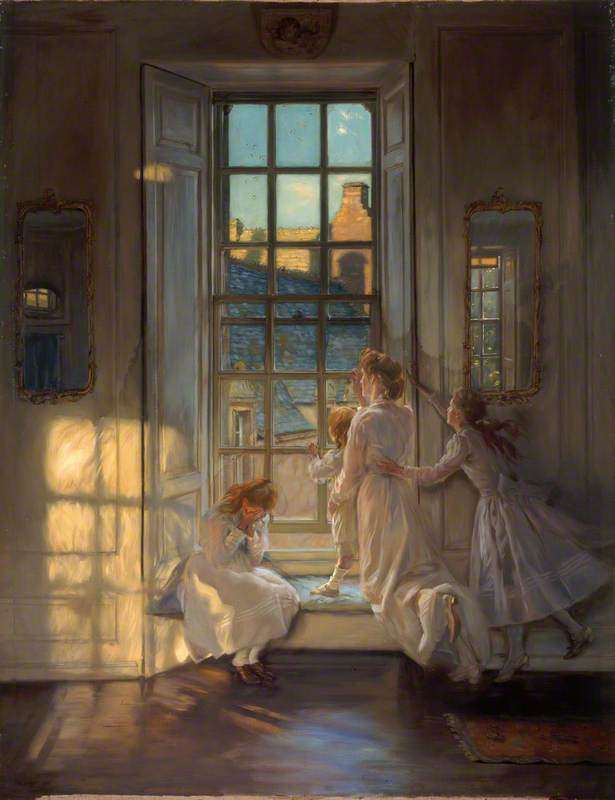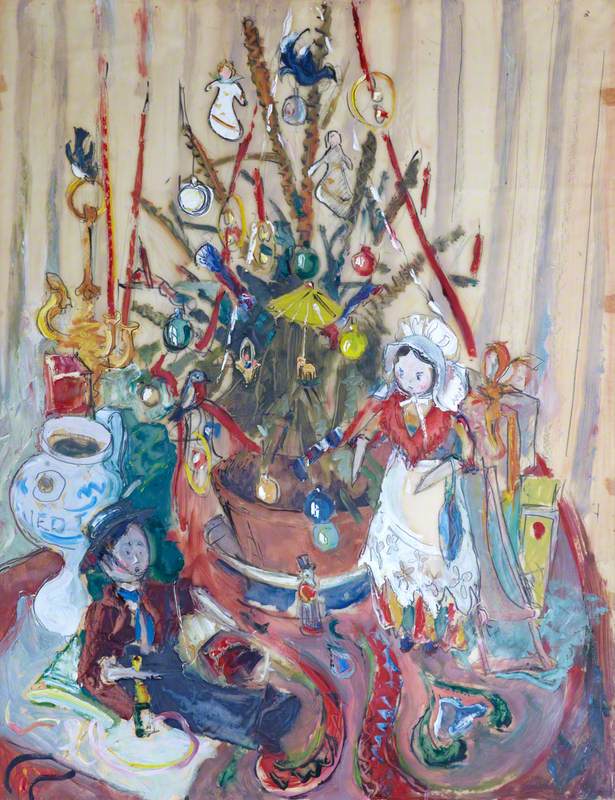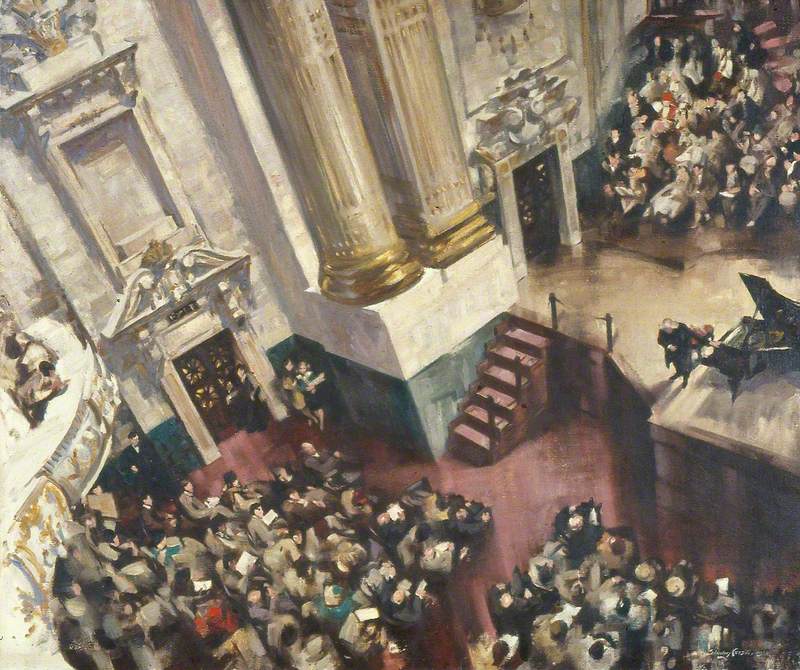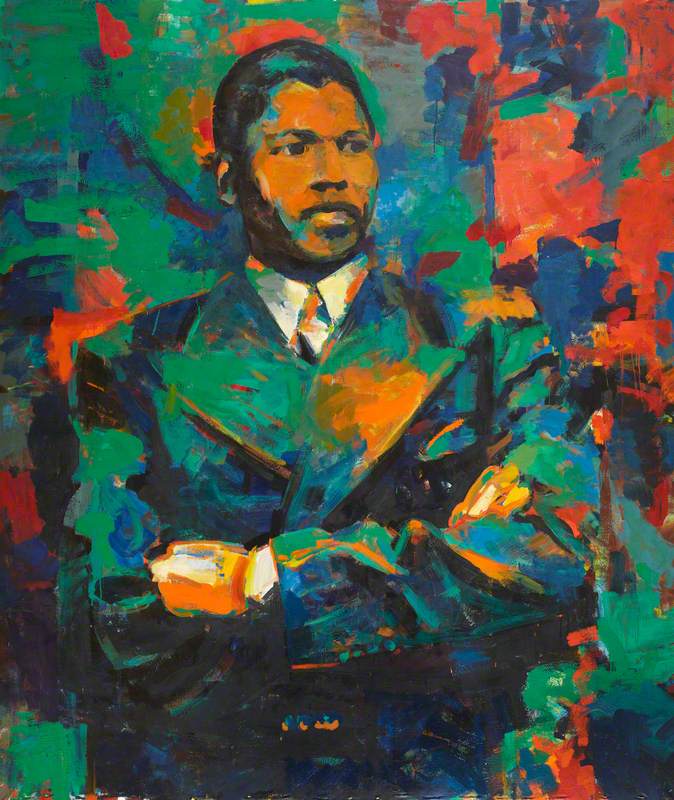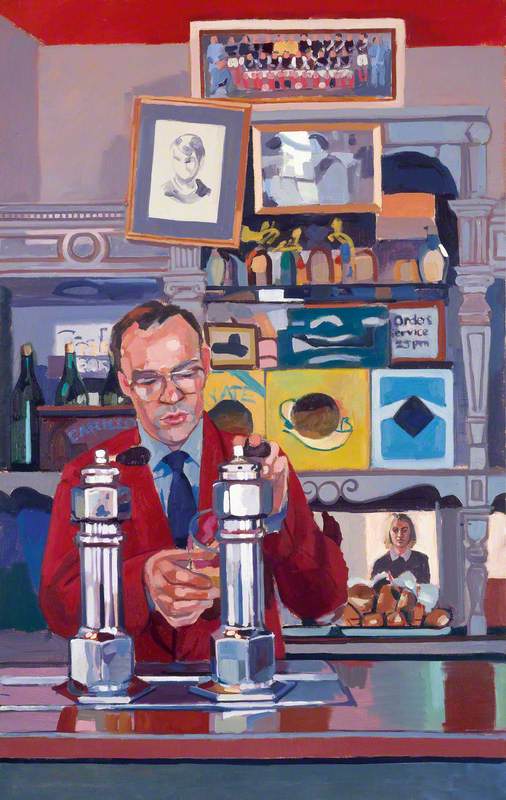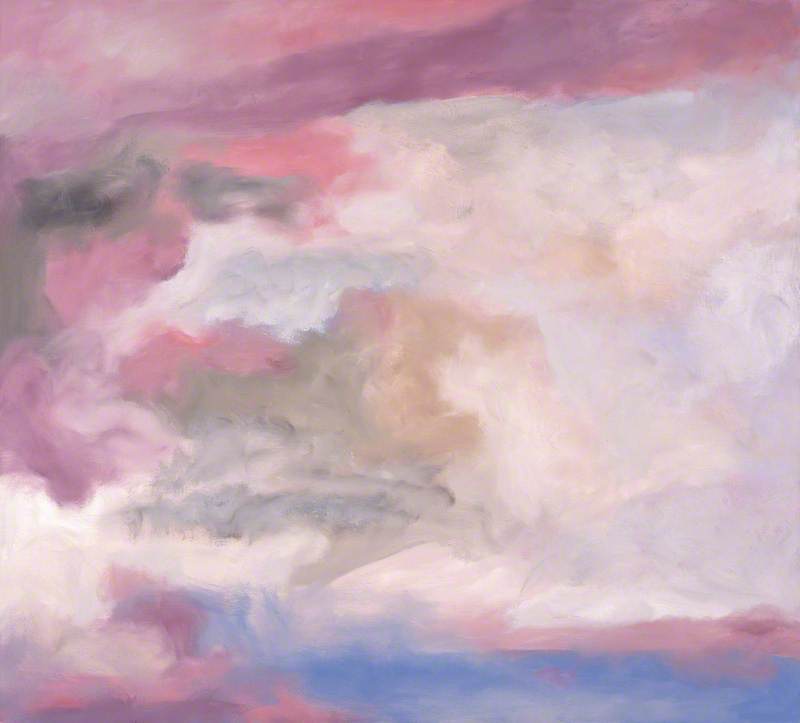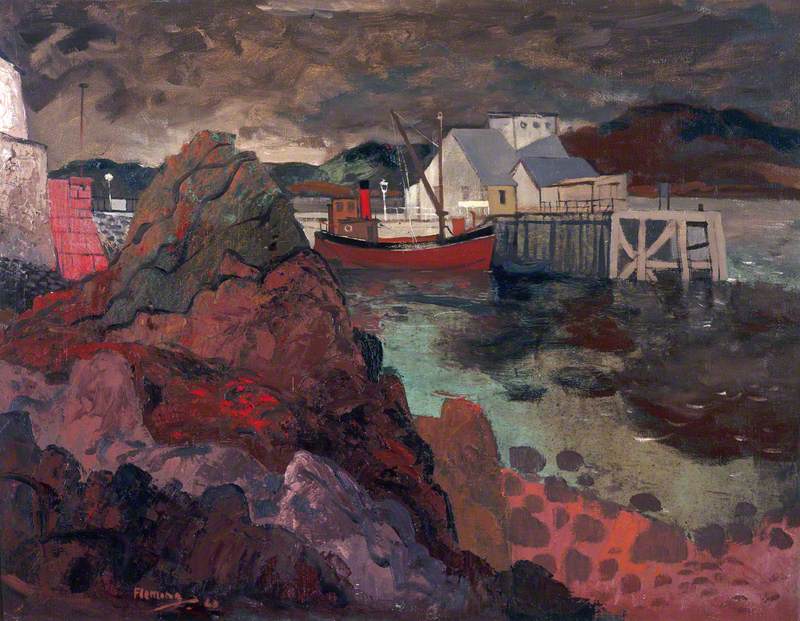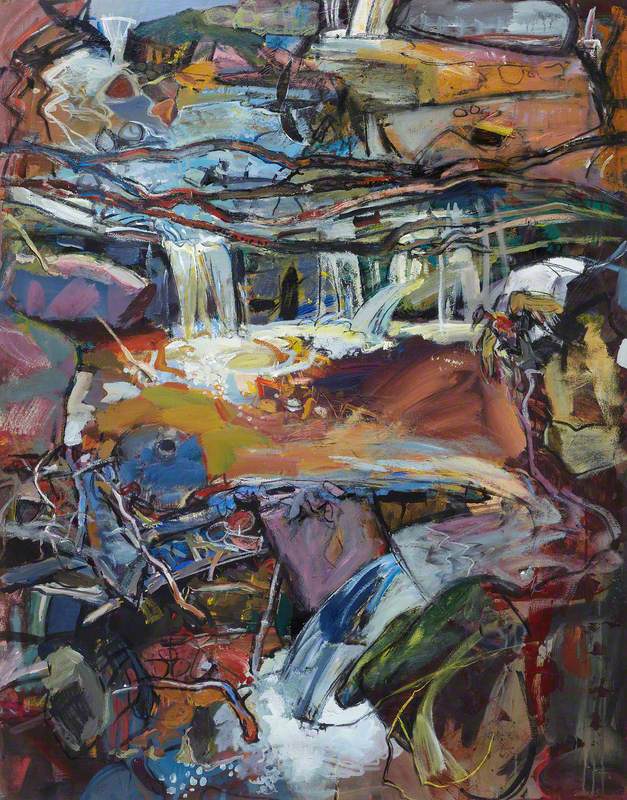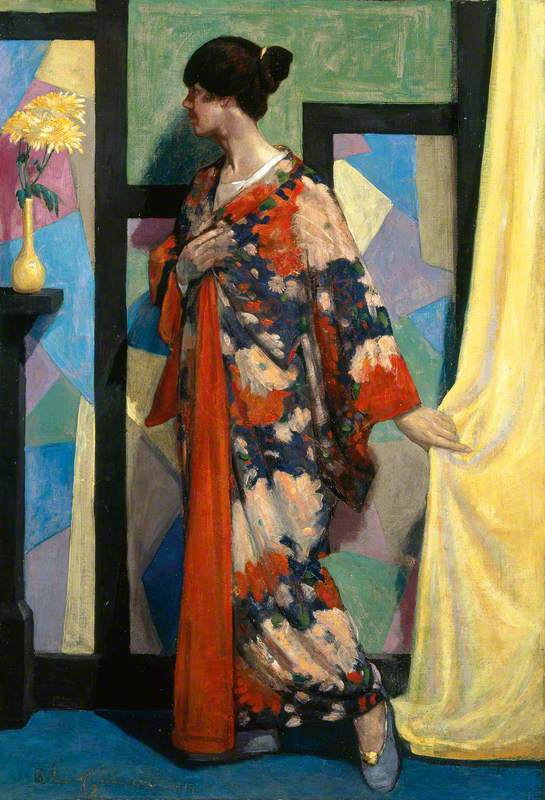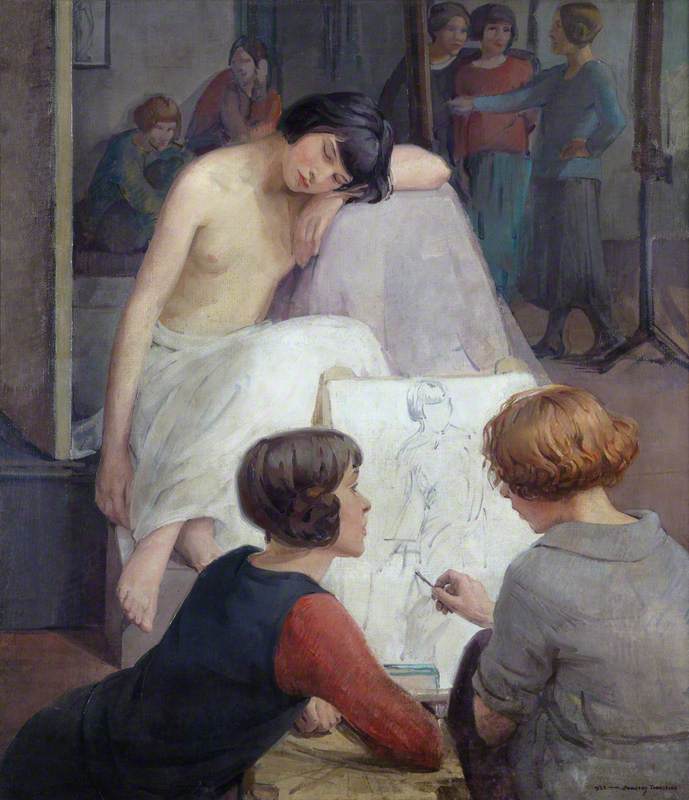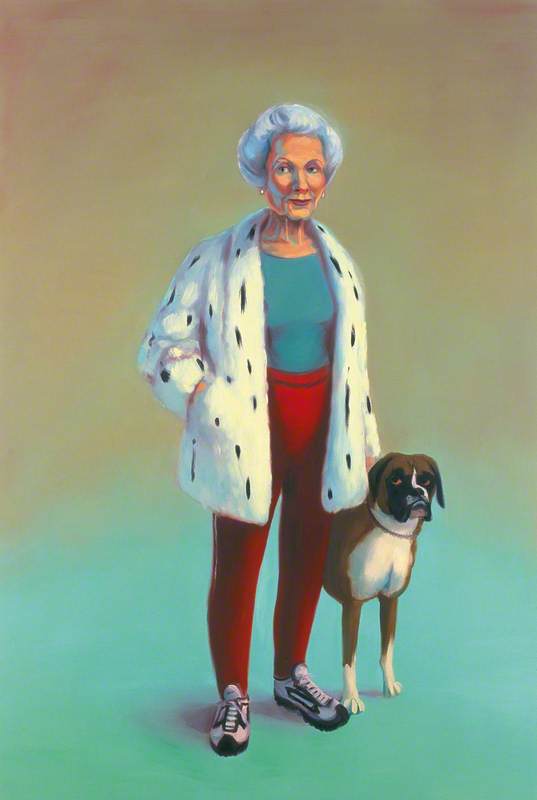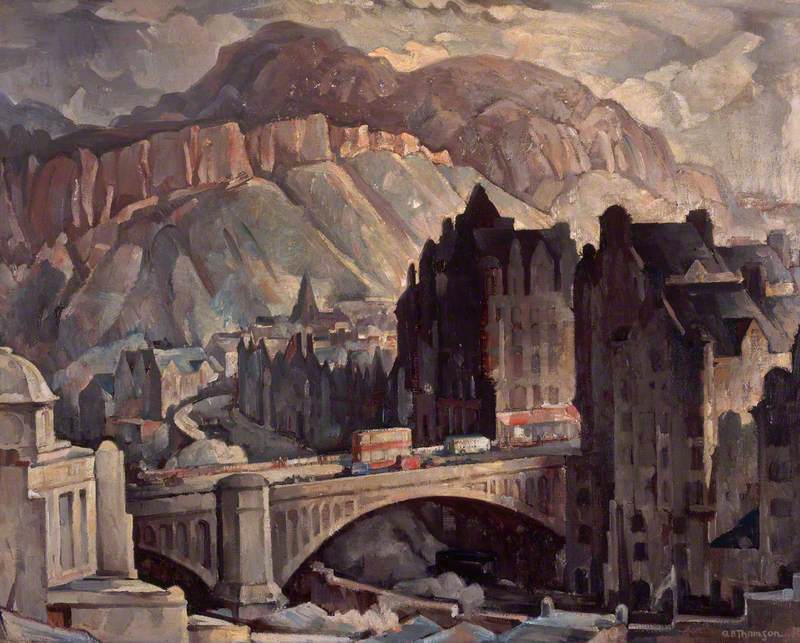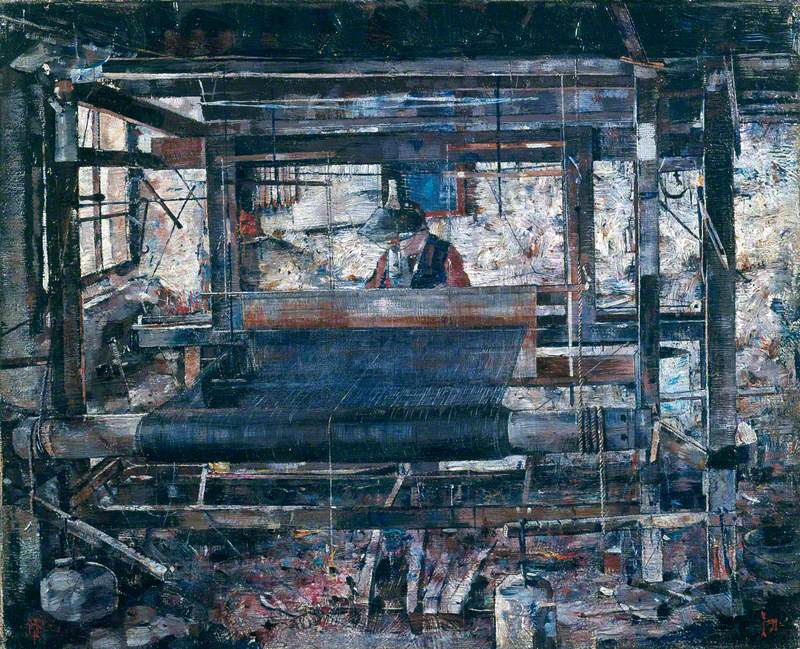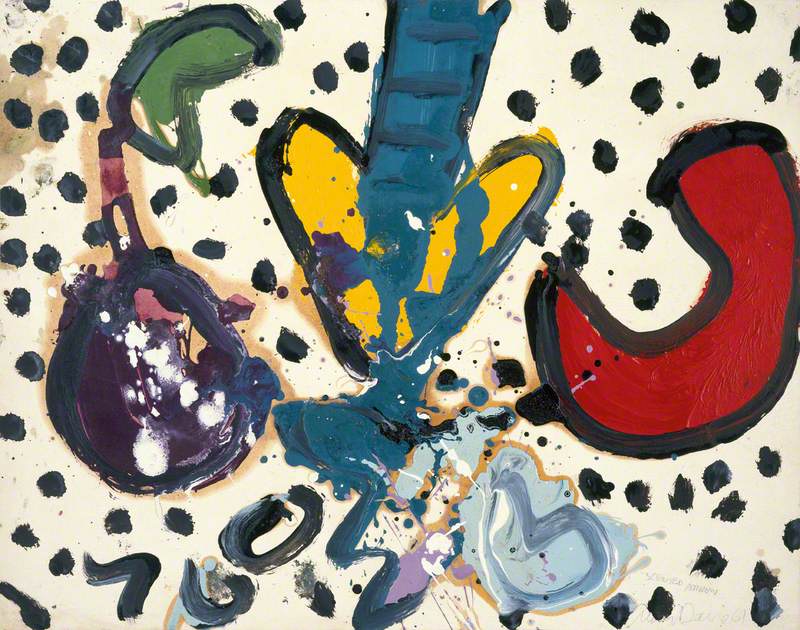To celebrate the City Art Centre turning 40 our Learning and Programmes Manager, Margaret Rose Findlay has curated an exhibition featuring choices from past members of staff who had a key role in the City Art Centre and guest curators and artists who have been closely connected to us over the years. We have a variety of classics in this exhibition with people choosing their favourites and telling us why. It is always delightful to get personal insights into our collection. Some old familiars are here, but some surprising choices have been highlighted.
-
'The Flight of the Swallows' by John Henry Lorimer (1856–1936)
The Flight of the Swallows 1906Margaret Rose Findlay is Learning and Programmes Manager and curator of this digital exhibition
I have worked with many paintings from the City Art Centre's collection over the years but this remains one of my firm favourites. Lorimer was born in Edinburgh, and was educated at Edinburgh Academy, Edinburgh University and in 1875 at the Royal Scottish Academy. This painting shows an elegant Edwardian Interior. The sun is setting at the end of the day and this stylish family watch as the swallows leave at the end of summer - symbolising change, decay and the loss of innocence. We live in a world where change is inevitable, as 2020 has shown us all! I love the gentle muted colours, light and shade and message in this lovely work.
John Henry Lorimer (1856–1936)
Oil on canvas
H 115 x W 89.6 cm
Museums & Galleries Edinburgh – City of Edinburgh Council
-
'Christmas' by Margaret Thomas (1916–2016)
ChristmasTessa Asquith-Lamb, Artist
I love 'Christmas' by Margaret Thomas. This nostalgic, treasure-filled still life embodies all I love about the festive season, old decorations, wrapped presents, wooden dolls and the sparkle of tinsel. I also like how the tiny tree is going a bit brown, and yet the cheery streamers and baubles cover this up. There is a quiet poetry and intensity to the tiny objects gathered together. I have collected antique trimmings for years and often put them in my own etchings and paintings as emblems of optimism and happiness in dark times. I love leading workshops at Christmas, and hopefully some of the lovely things made with my groups over the years will earn a place on the Christmas trees of the future.
Margaret Thomas (1916–2016)
Oil & charcoal on wax paper
H 91.5 x W 70.5 cm
Museums & Galleries Edinburgh – City of Edinburgh Council
-
Pachmann at the Usher Hall, Edinburgh
Pachmann at the Usher Hall, Edinburgh 1923Sandra Marwick ex Keeper of Education
In the current world crisis this painting is a reminder of what I have been missing with the closure of concert venues such as Edinburgh’s iconic Usher Hall. The painting records the pianist Vladimir de Pachmann, celebrated for his interpretations of the works of Chopin, speaking to his audience. Pachmann had an eccentric performance style which included gestures, muttering and addressing his listeners. By painting the scene from an off-centre angle in the grand circle of the auditorium the artist is making a reference to the quirky mannerisms of his subject. The Orcadian painter Stanley Cursiter, Keeper of the National Galleries of Scotland from 1930-1948, produced many fine landscapes and portraits.
Stanley Cursiter (1887–1976)
Oil on canvas
H 86.5 x W 101.6 cm
Museums & Galleries Edinburgh – City of Edinburgh Council
-
The Entry of George IV into Edinburgh from the Calton Hill by John Wilson Ewbank (c.1799–1847)
The Entry of George IV into Edinburgh from the Calton Hill, 1822 1827Dorothy Marsh, former Conservation Officer
Calton Hill, its buildings and monuments have a special place in my heart, as I often worked there. This painting depicts a grandiose event stage-managed by writer Sir Walter Scott, viewed looking down to Edinburgh from the top of the Calton Hill, with the Old Town to the left and the New Town to the right. Crowds, dressed in their finest, are everywhere, on the hillside and on rooftops, vying to get a glimpse of their King. Some buildings have changed but crowds on Calton Hill especially for big events like Beltane and Hogmanay remain a feature of the city.
John Wilson Ewbank (c.1799–1847)
Oil on canvas
H 150.5 x W 240 cm
Museums & Galleries Edinburgh – City of Edinburgh Council
-
View of Edinburgh by William Delacour (1700–1767)
View of Edinburgh 1759Derek Janes, former Assistant City Curator
This painting shows the Church and College of Holy Trinity founded by Mary of Gueldres, the Queen of King James II c.1460. When the railway into Edinburgh was built in the 1840s, the church was demolished. Lord Cockburn said
“this church was sacrificed, not to the necessities, but to the mere convenience of a railway. The railway had been finished and was in action. But it wanted a few yards of more room for its station, and these it got by the destruction of the finest piece of old architecture in Edinburgh.” The stones were numbered and in 1872 the building was partly re-erected in Chalmers Close, where it still stands, a remnant of one of the finest gothic buildings in Edinburgh.
William Delacour (1700–1767)
Oil on canvas
H 108.2 x W 229.1 cm
Museums & Galleries Edinburgh – City of Edinburgh Council
-
Nelson Mandela (1918–2013), at Nineteen 1986 by Lex Braes
Nelson Mandela (1918–2013), at Nineteen 1986Herbert Coutts, City Curator, 1971-99 & Director of Culture and Leisure, 1999-2007
Buying art for a public collection can get you in trouble! On a visit to the Demarco Gallery in 1986, I saw this large powerful work. A Government purchase grant was agreed and its acquisition approved. It was when the work was put on display in the Chambers that the balloon went up. Some Councillors were outraged that a portrait of an imprisoned "terrorist" had been added to the city's collection. The noise was so great that the Secretary of State for Scotland demanded an explanation. He backed off when informed that Government funding had been involved. Years later Nelson Mandela was acknowledged internationally as an outstanding statesman.
Lex Braes (b.1956)
Oil on canvas
H 208.6 x W 175.6 cm
Museums & Galleries Edinburgh – City of Edinburgh Council
-
The Diggers' Triptych
The Diggers' TriptychSandy Topp, former Head of Design
The Diggers depicts the Edinburgh pub The Athletic Arms. It’s been sandwiched between 2 graveyards since 1897 and was the ‘watering hole’ for the gravediggers who worked there, hence the more commonly used name. The Diggers is in many ways the quintessential Scottish traditional pub that Scots of a certain generation will recognise. I love this painting for what it means to me personally. The rallying cry at the start of every Five/Six Nations season “See you in Diggers” – a cry made never in confidence as so many variables could deny you the chance of meeting up with far-flung pals prior to the match at Murrayfield. Even without these pals the warmth and bonhomie was always there.
Maggie Milne (b.1957)
Oil on canvas
H 122 x W 76.5 cm
Museums & Galleries Edinburgh – City of Edinburgh Council
-
Final Instructions before Take-Off by Pat Douthwaite (1934–2002)
Final Instructions before Take-Off 1976Alison Chisholm was Curator of the Travelling Gallery from 1996 - 2015
Pat Douthwaite had a significant influence on my time as a student in the painting department of Glasgow School of Art. I was encouraged to study Douthwaite’s work by one of my tutors at GSA, painter Jim Hardie. A pilot himself, he was a big fan of Amy Johnson - the first woman to fly solo from London to Australia (1930). This painting is one of a series of works Douthwaite did of Amy Johnson, during a period when she created other works of strong historical women many also regarded as thinly veiled self-portraits. I love the simplicity of this painting, the arms as wings outstretched, the stylish aviator coat and glasses adding to the skull like features.
Pat Douthwaite (1934–2002)
Oil on canvas
H 152.3 x W 152.3 cm
Museums & Galleries Edinburgh – City of Edinburgh Council
-
'Study for a Monument' by William Brotherston (b.1943)
Study for a Monument 1977Paul McAuley former Conservation Officer with responsibility for statues and monuments in the City
As a conservator I always want to understand how artworks were inspired and created. This simple bronze pyramidal form topped by a cylinder inspired by a medieval church object - the ‘A of Charlemagne’ - belies the skill of the artist and the technical complexities of casting bronze. (The lost wax process involves creating a model from simple wax sheets then encased in a plaster-like ‘Ludo’ mould; after the wax is burned out molten metal is poured in taking on the form.) This artwork is pleasing to the eye when viewed from all angles, its surface texture, the colour of the copper alloy metal.
William Brotherston (b.1943)
Bronze
H 40 x W 27.5 x D 20.8 cm
Museums & Galleries Edinburgh – City of Edinburgh Council
-
Summer Day: Sleat (o/c 1070) by Jon Schueler (1916–1992)
Summer Day: Sleat (o/c 1070)Murdo Macdonald is Professor Emeritus of History of Scottish Art at the University of Dundee. He has a long relationship with the City Art Centre
In 1962 the American painter Jon Schueler wrote: ‘I realize that the Scottish landscape is the only one that I have a real passion for’. That passion is remarkable. Schueler is well known as a second-wave Abstract expressionist based in New York, yet some of his most significant work was done in Scotland from his house overlooking the Sound of Sleat. He treads that fascinating edge where abstraction and landscape become one and the same. The light and colour of the West Highlands has inspired artists from those who made the illuminated manuscripts of Iona to the Scottish Colourists.
Jon Schueler (1916–1992)
Oil on canvas
H 175 x W 192 cm
Museums & Galleries Edinburgh – City of Edinburgh Council
-
Kirn Pier, Winter by Ian Fleming (1906–1994)
Kirn Pier, Winter 1960Christina Jansen, The Scottish Gallery
There are many artists who are underrated and Ian Fleming is one of them. As an artist/art educator he influenced generations of artists from Glasgow School of Art and then later as Principal at Gray’s School of Art. This painting of Kirn Pier, Dunoon is an ambitious, modernist painting which combines a landscape, seascape, industry and social history. It’s got everything going on! I particularly like the contrasting pink and red rocky foreground, the puffer, the bold outlines of The Pier and the brooding sky. From 1933-1948, The Pier was owned by a Mr Imrie and it cost 1p to get on or off. Puffers unloaded coal and there was a sweet shop at the foot of Kirn Brae which was run by Mrs McGuggan.
Ian Fleming (1906–1994)
Oil on canvas
H 71.1 x W 91.9 cm
Museums & Galleries Edinburgh – City of Edinburgh Council
-
Muddy Pool by Duncan Shanks (b.1937)
Muddy PoolFernando Pacheco Bellas, former Designer
I love this work as it reflects very well a palette of intense and characteristic colours and at the same time it reminds us of the importance of keeping nature alive and clean. Muddy Pool, to me, is a very sensitive and reactionary work about the industrialization process in natural spaces and the consequences that this process later brings to our lives. This work has its own movement and a fluidity in its composition that makes the viewer concentrate on the centre of it, causing an adverse reaction to what is expected in a work on nature. The end result, when the water flows in the lower part, reminds us that nature always replenishes itself, no matter how difficult we make it.
Duncan Shanks (b.1937)
Acrylic on paper
H 148 x W 116.2 cm
Museums & Galleries Edinburgh – City of Edinburgh Council
-
Kimono Study by William McCance (1894–1970)
Kimono Study 1919Christine Vincenti, Trainee Museum Curator and Marketing Officer 1983 - 1996
I love so many paintings in the City Art Collection so it is hard to choose but one of my favourite paintings has to be ‘Kimono Study’ by William McCance. This painting is special to me as it reminds me so much of my sister who used to be an artist’s model in her younger days. The model in this painting is her doppelgänger and we still find it hard to believe it is not my sister. My sister is passionate about Japanese culture and has a collection of kimonos. I have a framed postcard of this painting.
William McCance (1894–1970)
Oil on canvas
H 111.7 x W 76.2 cm
Museums & Galleries Edinburgh – City of Edinburgh Council
-
Rest Time in the Life Class
Rest Time in the Life Class 1923Susan Mansfield is an art critic for the Scotsman & Art Writer
One of the battlegrounds for women artists at the turn of the 20th c. was the life room: while life drawing was essential to an artist’s training, it was seen as improper for young ladies to draw the naked human form. Johnstone, an outstanding painter who taught at Edinburgh College of Art 1914-1924, found an elegant solution: an all-female life class. Her painting invites us to glimpse what is accomplished in this private world. Having (to paraphrase Virginia Woolf) a room of their own, the women are drawing, resting, gossiping, discussing their work. They have room to explore, learn, disagree with one another, push out in new directions. They are becoming artists.
Dorothy Johnstone (1892–1980)
Oil on canvas
H 121.5 x W 106.2 cm
Museums & Galleries Edinburgh – City of Edinburgh Council
-
The Bibliophilist's Haunt (Creech's Bookshop) by William Fettes Douglas (1822–1891)
The Bibliophilist's Haunt (Creech's Bookshop) 1864Bev Casebow was Curator at Museum of Childhood and Curator of Applied Art
Those who know me won’t be surprised that I’ve chosen an image of a bookshop. I love books, and work in the National Library of Scotland. I wish this bookshop still existed; it looks like somewhere that I could spend many happy hours! I used to see this painting every day when I worked in the Museum of Edinburgh, and it seemed a natural extension of the wood-panelled interior of that building. I love the light and atmosphere in the painting, and the faces peering in at the window. William Creech (1745-1815) was the main publisher in Edinburgh for many years, and inherited his shop from the poet Allan Ramsay. It was located in the Royal Mile, close to St Giles.
William Fettes Douglas (1822–1891)
Oil on canvas
H 66.3 x W 86.7 cm
Museums & Galleries Edinburgh – City of Edinburgh Council
-
Happy Valley (I) by Moyna Flannigan (b.1963)
Happy Valley (I) 1999Sorcha Carey, Director of Edinburgh Art Festival
In Happy Valley I, we meet an elderly woman, pausing (or posing) with her dog. Dressed in an elegant ermine coat, oddly paired with stout walking shoes, she cuts an intriguing figure - her sharp outward gaze contrasting her dog’s rueful look. While researching genres of portraiture in an effort to critique them, and bring them into the contemporary world, Flannigan was especially drawn to the convention of portraying kings and nobles with their dogs – witness Goya and Velazquez. If portraits seek to fix and ground their subjects, this work occupies more ambiguous terrain. The inhabitants of Happy Valley float free of any reality, only finding their identity through paint.
Moyna Flannigan (b.1963)
Oil on linen
H 200 x W 135 cm
Museums & Galleries Edinburgh – City of Edinburgh Council
-
The Coal Yard by Kate Downie (b.1958)
The Coal Yard 1988Jane Warrilow, Curator 1992–2003
This work gives us a different view of Edinburgh. The artist has such a deft way with line and composition. I like that she places us not among the classical buildings and familiar views of the city but at the edge, in the coal yard, where the train wagons have arrived and lorries are being loaded, ready to leave when filled with fuel. At the top is Edinburgh’s skyline. We can make out one or two spires, and there’s the familiar shape of Salisbury Crags, and Arthur’s Seat. Yet the coal yard is centre stage, reminding us with our bird’s-eye view that these dirty, liminal spaces of activity are crucial to all cities. How important it is that artists choose to document such places in their work.
Kate Downie (b.1958)
Acrylic & coal dust on canvas
H 170 x W 177.5 cm
Museums & Galleries Edinburgh – City of Edinburgh Council
-
The Blue Lamp by John Duncan Fergusson (1874–1961)
The Blue Lamp 1912Alice Strang, Curator & Art Historian
The Blue Lamp by the Scottish Colourist John Duncan Fergusson is a magnificent example of twentieth-century Scottish art. Fergusson painted it in 1912 whilst living in Paris, where he was a ‘sociétaire’ of the progressive Salon d’Automne and a key figure in the celebrated Rhythm group of Anglo-American artists. Its bold colour, black outlining of form and ambitious composition show Fergusson’s awareness of – and contribution to – the latest developments in modern art. The Blue Lamp was acquired by Fergusson’s friend, the businessman and writer John Ressich, who gave it to the Scottish Modern Arts Association; they presented it to the City Art Centre in 1964.
John Duncan Fergusson (1874–1961)
Oil on panel
H 66 x W 57.2 cm
Museums & Galleries Edinburgh – City of Edinburgh Council
-
North Bridge and Salisbury Crags, Edinburgh, from the North West by Adam Bruce Thomson (1885–1976)
North Bridge and Salisbury Crags, Edinburgh, from the North WestStuart Mullen, former Accountant for Museums
In my opinion, there are none better than Thomson when it comes to capturing Edinburgh, known to be part of the ‘Edinburgh School of artists’. This view of our city not only serves as a tribute to Edinburgh, but captures a part of town I have trodden throughout my life. Enigmatic in its grey, muted tones, any Edinburgh local can relate to the grey cast over North Bridge and the Crags. Almost Futuristic in its approach, it is reminiscent of Nevinson’s ‘The Soul of the Soulless City’ portraying New York. The fine piece of engineering that is North Bridge, and nature’s own Salisbury Crags. The combination of 1930s modernism and Edinburgh’s rich history, make this painting timeless.
Adam Bruce Thomson (1885–1976)
Oil on canvas
H 109.2 x W 137.1 cm
Museums & Galleries Edinburgh – City of Edinburgh Council
-
The Loom by John Quinton Pringle (1864–1925)
The Loom‘The Loom’ (1891) by John Quinton Pringle (1864-1925)
Professor Elizabeth Cumming, Keeper of Fine Art Collections 1975-84
As the city’s first art curator a primary duty was to catalogue the city’s art collection from scratch. One of the most beautiful is John Quinton Pringle’s ‘The Loom’, an intimate study of a Glasgow weaver hard at work. It was well known that that this was the one I would rescue in case of a fire, and not only because it was small! Pringle was apprenticed to an optician and the painting uses tiny, fragmentary strokes of prismatic colour to evoke the threads, loom, weaver and the entire room. He was then attending evening classes at GSA, and this is as much a study in decorative patterning as a representational work.
John Quinton Pringle (1864–1925)
Oil on canvas
H 30.7 x W 37.5 cm
Museums & Galleries Edinburgh – City of Edinburgh Council
-
Scented Arrow Alan Davie (1920–2014)
Scented Arrow 1961Bill Hare is a curator and writer, and has had a long relationship with the City Art Centre
Bill chooses Scented Arrow by Alan Davie as his favourite City Art Centre painting. Bill is a lover of Haiku and this painting has inspired this poem:
Like the Zen archery masters
His “arrows” hit their targets-not from
The bow, but his brush.
Alan Davie (1920–2014)
Oil on paper laid on canvas
H 43.2 x W 54.6 cm
Museums & Galleries Edinburgh – City of Edinburgh Council
-
William MacGregor, an Edinburgh Porter by James Cumming (1732–1793)
William MacGregor, an Edinburgh PorterProfessor Duncan Macmillan is a Scottish art historian, art critic and writer
Willie McGregor’s badge identifies him as an Edinburgh porter, who were mostly Gaelic speaking. He was probably painted by James Cumming and is singing; he is a singing Gael. In 1760 James Macpherson’s Ossian caused immense excitement. His poetry was seen as the voice of ancient Caledonia, never subject to the Roman yoke and therefore free from the burden of the classical tradition. Cumming’s friend, Alexander Runciman, painted Ossian’s Hall in Penicuik House in 1772. Later destroyed by fire, it was in a brilliant style matching Macpherson’s Ossian. With his hair and neckerchief blowing in the wind, Willie, too, is very much in the character of Runciman’s Ossian.
James Cumming (1732–1793) (attributed to)
Oil on canvas
H 76.2 x W 62.2 cm
Museums & Galleries Edinburgh – City of Edinburgh Council
Explore artists in this Curation
View all 22-
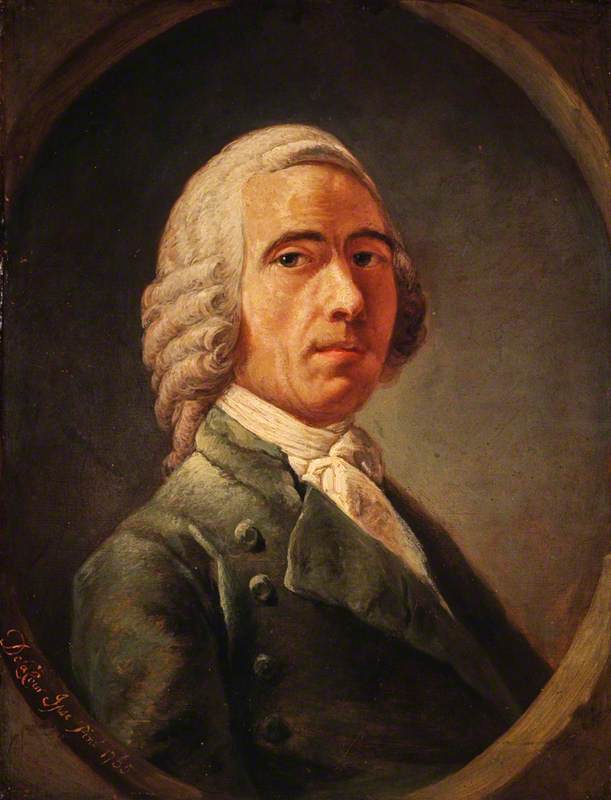 William Delacour (1700–1767)
William Delacour (1700–1767) -
 John Duncan Fergusson (1874–1961)
John Duncan Fergusson (1874–1961) -
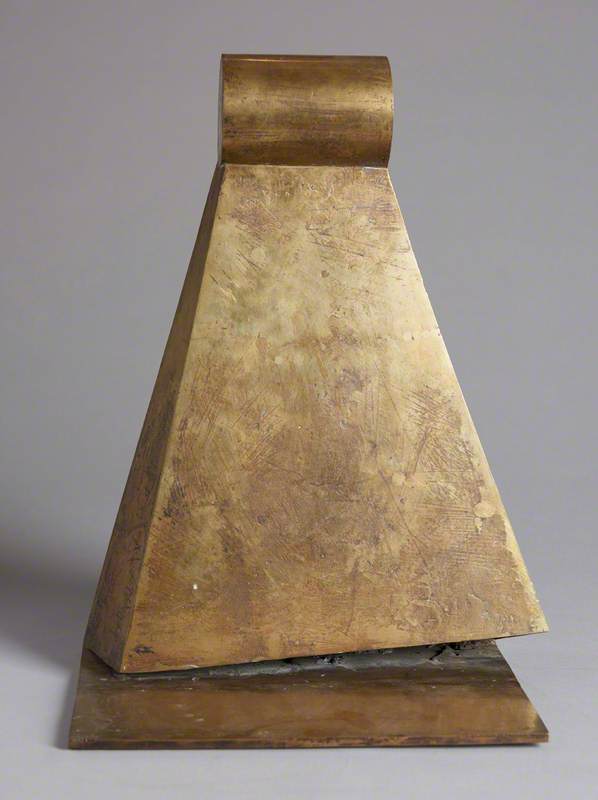 William Brotherston (b.1943)
William Brotherston (b.1943) -
 Moyna Flannigan (b.1963)
Moyna Flannigan (b.1963) -
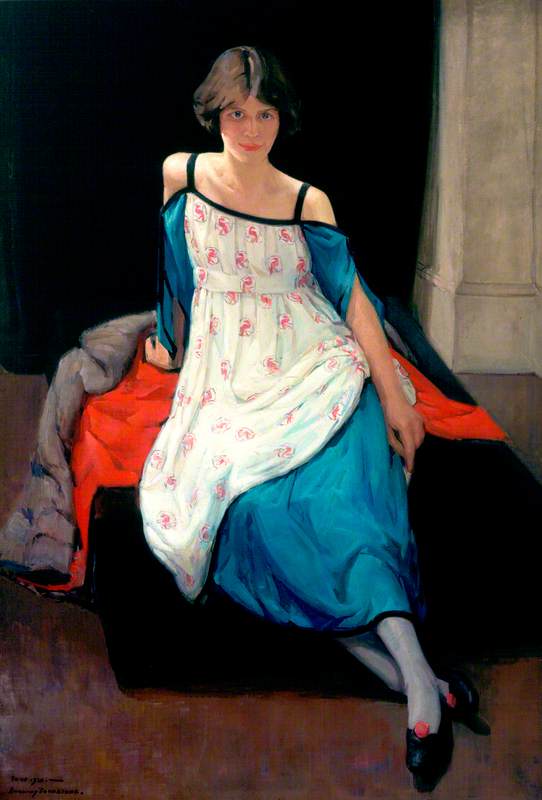 Dorothy Johnstone (1892–1980)
Dorothy Johnstone (1892–1980) -
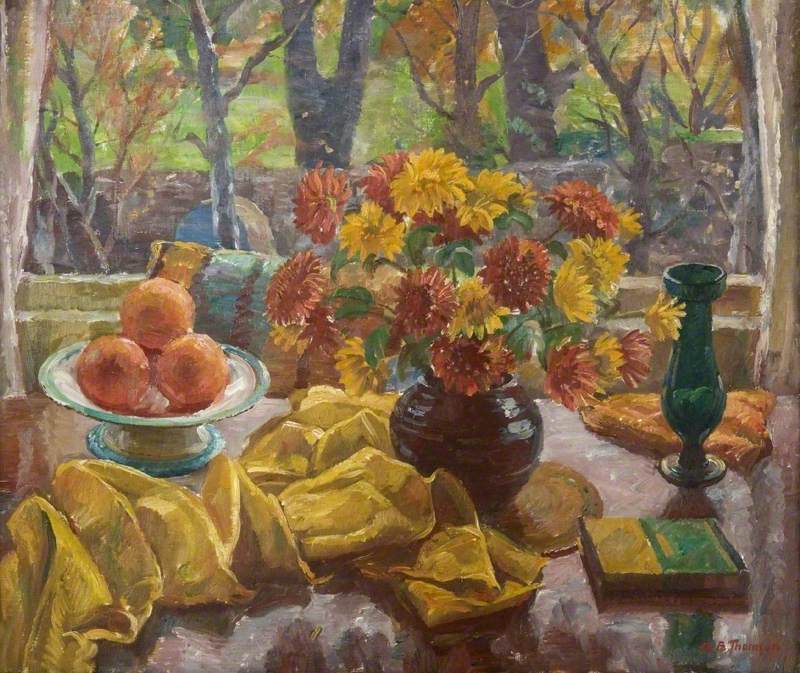 Adam Bruce Thomson (1885–1976)
Adam Bruce Thomson (1885–1976) -
 Jon Schueler (1916–1992)
Jon Schueler (1916–1992) -
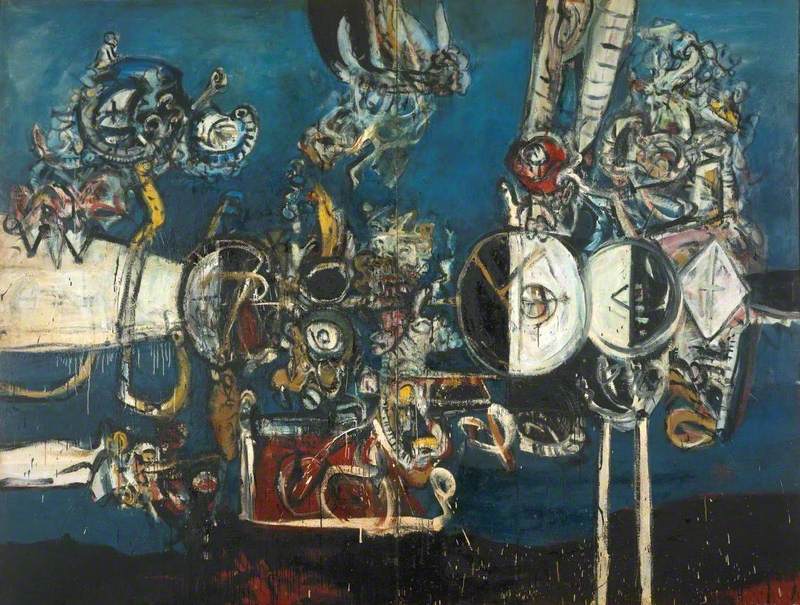 Alan Davie (1920–2014)
Alan Davie (1920–2014) -
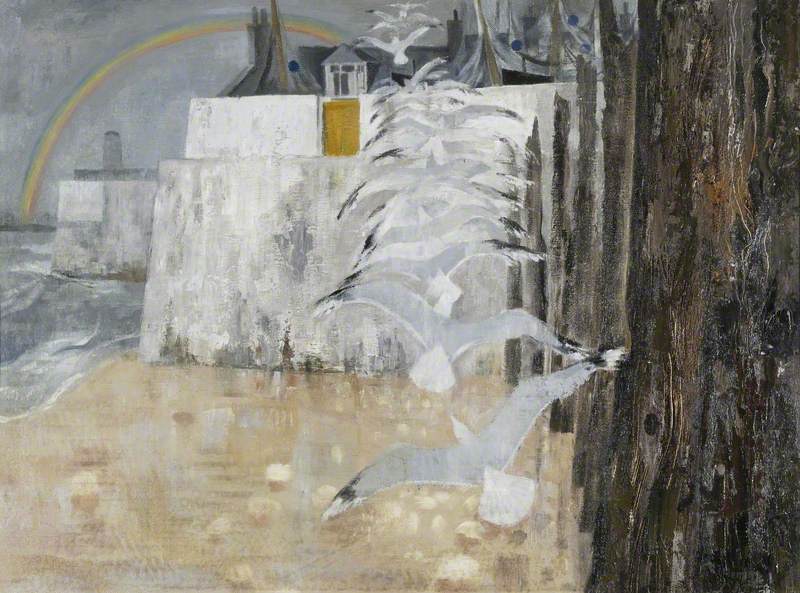 Ian Fleming (1906–1994)
Ian Fleming (1906–1994) -
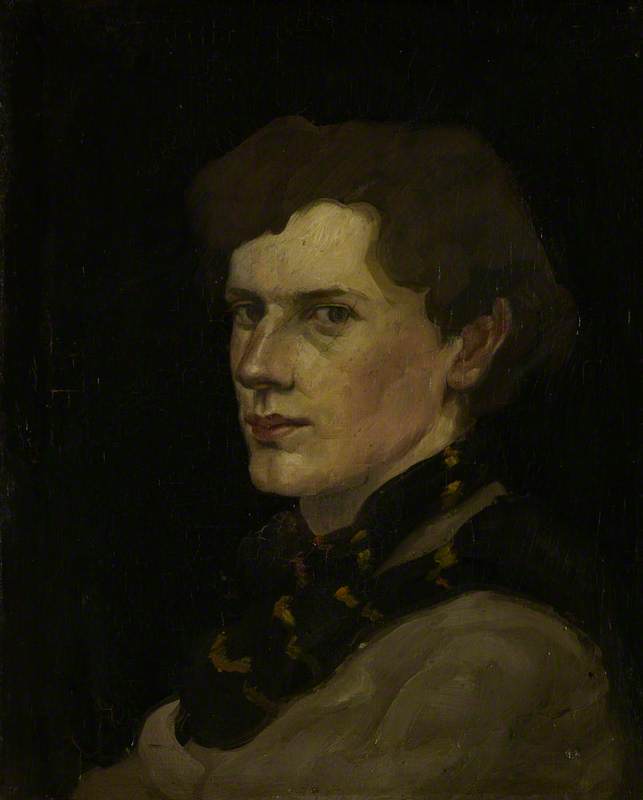 William McCance (1894–1970)
William McCance (1894–1970) - View all 22
